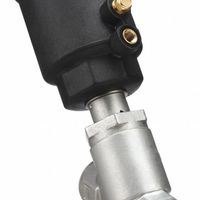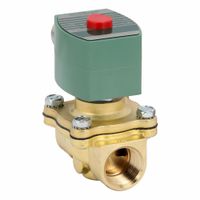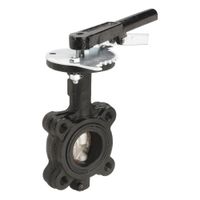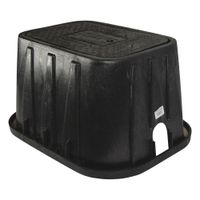Call +(254) 703 030 000 / 751 483 999 / 721 704 777
.....Read More
Frequently Asked Questions
What are the different types of plumbing valves?
Plumbing valves are essential components in any plumbing system, used to control the flow and pressure of water or other fluids. The main types include:
1. **Gate Valves**: These are used to completely stop or allow the flow of water. They operate by lifting a gate out of the path of the fluid. They are not suitable for flow regulation.
2. **Globe Valves**: Ideal for regulating flow, these valves have a spherical body and a movable disk-type element. They are used where flow needs to be adjusted frequently.
3. **Ball Valves**: Featuring a spherical disc to control flow, these valves are known for their durability and excellent shut-off capabilities. They are quick to operate and provide a tight seal.
4. **Butterfly Valves**: These have a rotating disc to control flow. They are compact, lightweight, and suitable for large volume water flow applications.
5. **Check Valves**: Designed to allow fluid to flow in one direction only, preventing backflow. They are essential in systems where backflow could cause damage or contamination.
6. **Pressure Relief Valves**: These automatically release pressure from a system when it exceeds a preset limit, ensuring safety and preventing damage.
7. **Needle Valves**: Used for precise flow control, these have a small port and a threaded, needle-shaped plunger. They are ideal for applications requiring fine adjustments.
8. **Diaphragm Valves**: These use a diaphragm to control flow and are suitable for corrosive or viscous fluids. They provide a tight seal and are easy to maintain.
9. **Angle Valves**: Often used in residential plumbing, these valves allow for a 90-degree turn in the piping system, controlling flow to fixtures like sinks and toilets.
10. **Solenoid Valves**: Electrically operated, these valves are used in automated systems to control the flow of liquids and gases.
Each type of valve serves a specific purpose and is chosen based on the requirements of the plumbing system.
How do shut-off valves work in plumbing systems?
Shut-off valves in plumbing systems control the flow of water or gas, allowing for maintenance, repair, or emergency stoppage. They are typically installed at key points, such as near fixtures or appliances, to isolate sections of the system without disrupting the entire network.
The basic operation involves a mechanism that opens or closes the valve. Common types include:
1. **Ball Valves**: These use a rotating ball with a hole through its center. When the handle is turned 90 degrees, the hole aligns with the pipe, allowing flow. Turning it back blocks the flow.
2. **Gate Valves**: These have a metal gate that moves up and down. Turning the handle raises the gate to allow flow or lowers it to stop flow. They are best for on/off control rather than flow regulation.
3. **Globe Valves**: These use a plug or disc that moves against a seat to control flow. They are suitable for regulating flow, as the design allows for precise control.
4. **Angle Valves**: Often used in residential plumbing, these are compact and direct flow at a 90-degree angle, making them ideal for tight spaces.
5. **Butterfly Valves**: These have a rotating disc that, when turned, aligns with the flow to allow passage or turns perpendicular to block it. They are used in larger systems.
Shut-off valves are crucial for safety and maintenance. They prevent water damage during leaks, allow for fixture replacement, and facilitate system repairs. Regular maintenance, such as exercising the valve by turning it on and off periodically, ensures reliability and prevents seizing.
What is the purpose of backflow prevention valves?
Backflow prevention valves are critical components in plumbing systems designed to protect potable water supplies from contamination or pollution due to backflow. Backflow occurs when the normal flow of water is reversed, potentially allowing contaminants to enter the clean water supply. This can happen due to backpressure or backsiphonage.
Backpressure occurs when the pressure in a system exceeds the pressure of the water supply, often due to pumps, boilers, or elevated tanks. Backsiphonage happens when there is a sudden drop in water pressure, such as during firefighting or a main break, creating a vacuum effect that draws water back into the supply line.
The primary purpose of backflow prevention valves is to ensure that water flows in only one direction, maintaining the integrity of the potable water system. These valves are installed at strategic points in the plumbing system, particularly where there is a risk of cross-connection between potable and non-potable water sources.
There are several types of backflow prevention devices, including:
1. **Air Gap**: A physical separation between the water supply and potential contaminants.
2. **Reduced Pressure Zone (RPZ) Valve**: Offers high-level protection by using a pressure differential to prevent backflow.
3. **Double Check Valve Assembly (DCVA)**: Consists of two check valves for moderate protection.
4. **Pressure Vacuum Breaker (PVB)**: Prevents backsiphonage by using a spring-loaded check valve and an air inlet valve.
By preventing backflow, these valves protect public health by ensuring that drinking water remains safe and free from harmful substances, chemicals, or pathogens that could cause illness or disease. They are essential in residential, commercial, and industrial settings, particularly where hazardous materials are used or stored.
How do float valves function in a plumbing system?
Float valves are mechanical devices used in plumbing systems to regulate the flow of liquid, typically in tanks or cisterns. They function by using a buoyant object, known as a float, which rises and falls with the liquid level. Here's how they work:
1. **Float Mechanism**: The float is usually a hollow, sealed object made of plastic or metal that floats on the surface of the liquid. It is attached to a lever arm.
2. **Lever Arm**: The lever arm connects the float to the valve mechanism. As the liquid level changes, the float moves up or down, causing the lever arm to pivot.
3. **Valve Operation**: The lever arm is connected to a valve that controls the flow of liquid into the tank. When the liquid level is low, the float drops, causing the lever arm to open the valve. This allows more liquid to flow into the tank.
4. **Shutting Off Flow**: As the tank fills, the float rises. Once the desired liquid level is reached, the float lifts the lever arm to a position that closes the valve, stopping the flow of liquid.
5. **Maintaining Level**: The float valve maintains a consistent liquid level by automatically opening and closing the valve as needed. This prevents overflow and ensures a steady supply of liquid.
6. **Applications**: Float valves are commonly used in toilet tanks, water storage tanks, and cooling systems. They are essential for maintaining water levels without manual intervention.
7. **Adjustability**: Many float valves allow for adjustment of the float position, enabling control over the liquid level at which the valve opens or closes.
By using the principles of buoyancy and mechanical leverage, float valves provide an efficient and reliable method for controlling liquid levels in various plumbing applications.
What is the role of flow control valves in regulating fluid pressure?
Flow control valves play a crucial role in regulating fluid pressure within a system by managing the flow rate of the fluid. These valves adjust the flow rate to maintain the desired pressure levels, ensuring the system operates efficiently and safely. By controlling the flow rate, they help in maintaining the balance between the supply and demand of fluid within the system.
Flow control valves can be manually operated or automatically controlled. In automatic systems, they often work in conjunction with sensors and controllers to adjust the valve position based on real-time pressure readings. This dynamic adjustment helps in maintaining consistent pressure levels despite variations in demand or supply conditions.
The primary function of these valves is to restrict or allow fluid flow, which directly impacts the pressure. When the valve is partially closed, it reduces the flow rate, leading to an increase in upstream pressure and a decrease in downstream pressure. Conversely, opening the valve increases the flow rate, reducing upstream pressure and increasing downstream pressure.
Flow control valves are essential in various applications, including hydraulic systems, water distribution networks, and process industries. They ensure that the system components are protected from pressure surges and fluctuations, which can cause damage or reduce efficiency. By maintaining optimal pressure levels, these valves contribute to the longevity and reliability of the system.
In summary, flow control valves are vital for regulating fluid pressure by controlling the flow rate, ensuring system stability, efficiency, and safety. They adapt to changing conditions to maintain the desired pressure, protecting system components and optimizing performance.
How do pressure control valves differ from temperature control valves?
Pressure control valves and temperature control valves serve distinct functions in fluid systems, each tailored to manage different parameters.
Pressure control valves are designed to regulate the pressure within a system. They maintain a desired pressure level by adjusting the flow of fluid, either by opening to release excess pressure or closing to increase pressure. These valves are crucial in systems where maintaining a specific pressure is essential for safety and efficiency, such as in hydraulic systems, gas pipelines, and water supply networks. Common types include pressure relief valves, pressure reducing valves, and back-pressure regulators.
Temperature control valves, on the other hand, are used to regulate the temperature of a fluid. They achieve this by controlling the flow of a heating or cooling medium, such as steam or chilled water, to maintain a set temperature. These valves are vital in processes where temperature stability is critical, such as in HVAC systems, chemical processing, and food production. Types include thermostatic mixing valves, temperature regulating valves, and three-way valves.
The primary difference lies in their control objectives: pressure control valves focus on maintaining pressure, while temperature control valves focus on maintaining temperature. Additionally, the mechanisms and sensors used in each type of valve differ. Pressure control valves often use pressure sensors and diaphragms, while temperature control valves use thermostatic elements or temperature sensors.
In summary, while both types of valves are integral to fluid system management, they differ fundamentally in their purpose, operation, and application, with pressure control valves managing pressure levels and temperature control valves managing temperature levels.
What are solenoid valves and how do they operate?
Solenoid valves are electromechanically operated valves used to control the flow of liquids or gases. They consist of a solenoid, which is a coil of wire that generates a magnetic field when an electric current passes through it, and a valve mechanism that opens or closes in response to the magnetic field.
The operation of a solenoid valve involves several key components: the solenoid coil, the plunger or armature, the spring, and the valve body. When the solenoid coil is energized by an electrical current, it creates a magnetic field that attracts the plunger. This movement of the plunger either opens or closes the valve, depending on the design.
There are two main types of solenoid valves: direct-acting and pilot-operated. In direct-acting solenoid valves, the plunger directly opens or closes the valve orifice. These are typically used for smaller flow rates and lower pressure applications. In pilot-operated solenoid valves, the plunger controls a pilot orifice, which in turn controls the main valve orifice. This type is suitable for larger flow rates and higher pressure applications.
Solenoid valves can be normally open (NO) or normally closed (NC). In a normally closed valve, the valve remains closed when the solenoid is not energized, and opens when the solenoid is activated. Conversely, a normally open valve remains open when not energized and closes when the solenoid is activated.
Solenoid valves are widely used in various applications, including fluid power pneumatic and hydraulic systems, to control cylinders, fluid power motors, or larger industrial valves. They are also used in domestic appliances, such as dishwashers and washing machines, to control water flow. Their advantages include fast response time, reliability, and ease of integration into automated systems.
How do air-operated piston valves function?
Air-operated piston valves function by using compressed air to control the movement of a piston within a cylinder, which in turn opens or closes the valve. These valves are typically used for controlling the flow of fluids or gases in a pipeline.
The main components of an air-operated piston valve include the valve body, piston, cylinder, and actuator. The valve body contains the flow passage and the seat where the piston seals to stop the flow. The piston is connected to a stem that extends into the cylinder, which is part of the actuator assembly.
When compressed air is supplied to the actuator, it enters the cylinder and exerts pressure on the piston. This pressure causes the piston to move, either lifting it off the seat to open the valve or pressing it down onto the seat to close the valve. The direction of the piston's movement depends on the design of the valve and the configuration of the air supply.
The air supply is typically controlled by a solenoid valve, which directs the air to either side of the piston. When the solenoid valve is energized, it allows air to flow into the cylinder, moving the piston and changing the valve's state. When de-energized, the air is vented, and a spring or the pressure differential returns the piston to its original position.
Air-operated piston valves are favored for their reliability, quick response, and ability to handle high-pressure applications. They are commonly used in industries such as chemical processing, water treatment, and food and beverage production, where precise control of fluid flow is essential.
What are valve actuators and how are they used in plumbing systems?
Valve actuators are devices used to automate the operation of valves, enabling them to be opened, closed, or modulated remotely or automatically. They convert a control signal into mechanical motion to operate the valve. Actuators can be powered by various sources, including electric, pneumatic, or hydraulic energy.
In plumbing systems, valve actuators are crucial for controlling the flow of water or other fluids. They are used in various applications, such as water treatment plants, heating systems, and industrial processes, where precise control over fluid flow is necessary.
Electric actuators are commonly used in plumbing systems for their precision and ease of integration with control systems. They are ideal for applications requiring frequent operation and precise positioning. Pneumatic actuators, powered by compressed air, are preferred in environments where electrical devices might pose a risk, such as in explosive atmospheres. Hydraulic actuators, using pressurized fluid, are suitable for high-force applications.
Valve actuators enhance the efficiency and safety of plumbing systems by allowing for remote operation, reducing the need for manual intervention. They can be integrated with sensors and control systems to enable automated responses to changing conditions, such as adjusting flow rates based on demand or shutting off valves in case of a leak. This automation helps in optimizing system performance, conserving energy, and minimizing downtime.
Overall, valve actuators are essential components in modern plumbing systems, providing reliable and efficient control over fluid flow, contributing to the system's overall functionality and safety.
Why are valve boxes and enclosures important for protecting plumbing components?
Valve boxes and enclosures are crucial for protecting plumbing components due to several key reasons:
1. **Physical Protection**: They shield valves and other plumbing components from physical damage caused by external forces such as foot traffic, vehicles, or equipment. This is particularly important in areas with heavy activity, where exposed components could be easily damaged.
2. **Environmental Shielding**: Valve boxes and enclosures protect against environmental factors like rain, snow, ice, and UV radiation, which can cause corrosion, rust, or degradation of plumbing materials over time. This protection extends the lifespan of the components and ensures reliable operation.
3. **Access and Maintenance**: These enclosures provide a designated access point for maintenance and operation, making it easier for technicians to locate and service the valves without disturbing the surrounding infrastructure. This organized access reduces the time and cost associated with repairs and maintenance.
4. **Safety**: By enclosing plumbing components, valve boxes prevent accidental contact with hot, pressurized, or hazardous materials, thereby enhancing safety for both workers and the public. This is especially important in industrial or public settings.
5. **Aesthetic and Functional Integration**: Valve boxes can be designed to blend with the surrounding environment, maintaining the aesthetic appeal of a landscape or urban area. They also help in organizing plumbing systems, preventing clutter and confusion.
6. **Security**: Enclosures can be locked or secured to prevent unauthorized access or tampering, which is vital in preventing vandalism or accidental operation that could lead to system failures or water wastage.
Overall, valve boxes and enclosures are essential for ensuring the durability, functionality, and safety of plumbing systems, while also facilitating efficient maintenance and operation.








